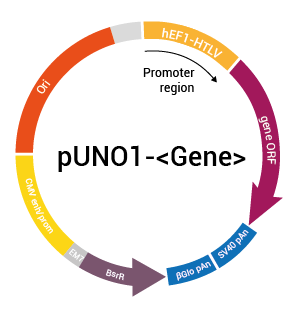pUNO and pDUO
Cloning and expression plasmid for one or two genes of interest
pUNO and pDUO plasmids feature a wide choice of ~ 1,800 full-length sequenced native and fusion genes. They can be used for in vitro or in vivo transfection experiments.
These plasmids are provided as open reading frames (ORFs) from the ATG to the Stop codon, excluding introns and untranslated regions.
Within a pUNO plasmid, the gene of interest is under the control of the strong and ubiquitous mammalian promoter, EF1α/HTLV. This allows for the expression of one gene of interest. pDUO plasmids feature two strong composite promoters derived from the ferritin light chain (FerL) and heavy chain (FerH) core promoters, enabling the co-expression of two genes simultaneously.
Key features of InvivoGen's pUNO & pDUO plasmids
- Contain genes from different species (human, mouse, bovine, pork, rat, etc.)
- Selectable in both bacterial and mammalian cells
- Simple to subclone due to unique restriction sites
- Choice of engineered genes (mutations, tagged, CpG-free)
- Control plasmids pUNO-mcs and pDUO-mcs featuring multiple cloning sites (mcs) are also available
Plasmid Features
-
Promoter region: hEF1-HTLV promoter for pUNO & hFerH and hFerL composite promoters for pDUO expression plasmids. Please refer to the Technical Data Sheet (TDS) of pUNO or pDUO plasmids for further information.
-
SV40 pAn: The Simian Virus 40 late polyadenylation signal enables efficient cleavage and polyadenylation reactions resulting in high levels of steady-state mRNA.
-
Ori: A minimal E. coli origin of replication (Ori) with the same activity as the longer Ori.
-
CMV enh/prom: The human cytomegalovirus immediate-early gene 1 promoter/enhancer was originally isolated from the Towne strain and was found to be stronger than any other viral promoters.
-
Resistance genes: The resistance genes are driven by the SV40 promoter in tandem with the bacterial EM7 promoter to allow antibiotic selection in both mammalian cells and E. coli bacteria. Most pUNO plasmids are selectable with Blasticidin (pUNO1). Some are also provided with a Zeocin® (pUNO2), Hygromycin (pUNO3), or Puromycin (pUNO4) resistance.
- βGlo pAn: The human beta-globin 3’UTR and polyadenylation sequence allow efficient arrest of the transgene transcription.





